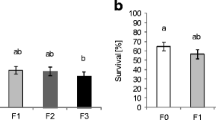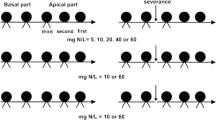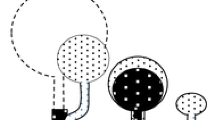Abstract
A special type of clonal growth, spread by lateral roots, ishypothesized to be a favourable trait of invasive, opportunistic plant speciesof disturbed habitats. We tested this hypothesis for the invasive forbRorippa austriaca (Brassicaceae). Regenerationfrom root fragments, subsequent vegetative spread and allocation patterns inrelation to varied nutrient supply and intensity and pattern of interspecificcompetition were analyzed in container experiments. Regeneration success fromroot fragments was 100% and clonal spread was rapid but vegetativeperformance was strongly reduced under unfertilized conditions and,particularly, when interspecific competition was present. While the ratio ofabove- to belowground bio-mass did not differ considerably betweentreatments, R. austriaca allocated a high amount ofresources to belowground growth resulting in low aboveground but highbelowground biomass at harvest time relative to the matrix vegetation.Differences in shoot number or biomass between simulated gaps and denselyvegetated quadrants in the containers were (relatively) weak.Reproductive effort was less reduced under low resource levels, and the clonesdid not set seed at all, irrespective of the treatment. Our results show thatclonal growth by lateral roots and plasticity in clonal growth patterns inR. austriaca promote both exploitation of gaps andnutrient-rich microsites and resistance to competitors. Such plasticity,combined with its ability to regenerate from widely-dispersed rootfragments, contribute to the ability of the species to invade and persistwithindisturbed and spatially heterogeneous habitats.
Similar content being viewed by others
References
Bayerische Landesanstalt für Bodenkultur und Pflanzenbau 1997. Leitfaden für die Düngung von Acker-und Grünland. In:, Rist Satz & Druck. Bayerische Landesanstalt, Ilmünster Rist Satz & Druck. Bayerische Landesanstalt, Ilmünster.
Bazzaz F.A. 1983. Characteristics of populations in relation to disturbance in natural and man-modified ecosystems. In: Mooney H.A. and Godron M. (eds), Disturbance and Ecosystems. Ecological Studies 44. Springer Verlag, Berlin, pp. 259-275.
Bazzaz F.A. 1986. Life history of colonizing plants: some demographic, genetic and physiological features. In: Mooney H.A. and Drake J.A. (eds), Ecology of Biological Invasions of North America and Hawaii. Ecological Studies 58. Springer Verlag, New York, pp. 96-110.
Brewer J.S. and Bertness M.D. 1996. Disturbance and intraspecific variation in the clonal morphology of salt marsh perennials. Oikos 77: 107-116.
Chapin F.S., Schulze E.-D. and Mooney H.A. 1990. The ecology and economics of storage in plants. Annual Review of Ecology and Systematics 21: 423-447.
Cheplick G.P. 1997. Responses to severe competitive stress in a clonal plant: differences between genotypes. Oikos 79: 581-591.
Cook R.E. 1985. Growth and development in clonal plant populations. In: Jackson J.B.C., Buss L.W. and Cook R.E. (eds), Population Biology and Evolution of Clonal Organisms. Yale University Press, New Haven, pp. 254-296.
de Kroon H. and Schieving F. 1990. Resource partitioning in relation to clonal growth strategy. In: van Groenendael J. and de Kroon H. (eds), Clonal Growth in Plants: Regulation and Function. SPB Academic Publishing, The Hague, pp. 113-130.
Dietz H. and Ullmann I. 1997. Age-determination of dicotyledonous herbaceous perennials by means of annual rings: exception or rule? Annals of Botany 80: 377-379.
Dietz H. and Steinlein T. 1998. The impact of anthropogenic disturbance on life stage transitions and stand regeneration of the invasive alien plant Bunias orientalis L. In: Edwards K., Kowarik I., Starfinger U. and Williamson M. (eds), Plant Invasions-Ecological Mechanisms and Human Responses. Backhuys Publishers, Leiden, pp. 169-184.
Dietz H., Steinlein T. and Ullmann I. 1999. Establishment of the invasive perennial herb Bunias orientalis L.: an experimental approach. Acta Oecologica 20: 1-13.
Fahrig L., Coffin D.P., Lauenroth W.K. and Shugart H. 1994. The advantage of long distance spreading in highly disturbed habitats. Evolutionary Ecology 8: 172-187.
Gädeke M. 1998. Klonale Struktur und Expansion des Neophyten Rorippa austriaca.
Grubb P.J. 1977. The maintenance of species richness in plant communities: the importance of the regeneration niche. Biological Review 52: 107-145.
Haeupler H. and Schönfelder P. 1988. Atlas der Farn-und Blüten-pflanzen der Bundesrepublik Deutschland. Ulmer, Stuttgart.
Harper J.L. 1977. Population Biology of Plants. Academic Press, London.
Harper J.L. and White J. 1974. The demography of plants. Annual Review of Ecology and Systematics 5: 419-463.
Hultén E. and Fries M. 1986. Atlas of North European vascular plants. Vol. 1. Koeltz, Königstein.
Jalas J. and Suominen J. 1994. Atlas Florae Europaeae. Cruciferae (Ricotia to Raphanus). Vol. 10., Helsinki.
Klimeš L. and Klimešvá J. 1999a. Root sprouting in Rumex aceto-sellaunder different nutrient levels. Plant Ecology 141: 33-39.
Klimeš L. and Klimešová J. 1999b. CLO-PLA2-a database of clonal plants in central Europe. Plant Ecology 141: 9-19.
Klimeš L., Klimešová J., Hendriks R. and van Groenendael J. 1997. Clonal plant architecture: a comparative analysis of form and function. In: de Kroon H. and van Groenendael J. (eds), The Ecology and Evolution of Clonal Plants. Backhuys Publishers, Leiden, pp. 1-29.
Lindman H.R. 1974. Analysis of variance in complex experimental designs. Freeman, San Francisco.
Lubke M.A. and Cavers P.B. 1970. Studies of vegetative regeneration in Saponaria offýcinalis L. (soapwort) and Silene cucubalus Wibel (bladder campion). Canadian Field Naturalist 84: 43-47.
Lym R.G. 1998. The Biology and integrated management of leafy spurge (Euphorbia esula) on North Dakota rangeland. Weed Technology 12: 367-373.
Maun H. and Cavers P.B. 1979. The regenerative capacity of root cuttings of Taraxacum officinale under natural conditions. Canadian Journal of Botany 57: 1783-1791.
Milliken G.A. and Johnson D.E. 1984. Analysis of Messy Data: Designed Experiments. Vol. 1. Van Nostrand Reinhold, New York.
Peterson R.L. 1975. The initiation and development of root buds. In: Torrey J.G. and Clarkson T.D. (eds), The Development and Function of Roots. Academic Press, London, pp. 125-161.
Prach K. and Pyšek P. 1994. Clonal plants-what is their role in succession? Folia Geobotanica et Phytotaxonomica 29: 307-320.
Pyšek P. 1995. On the terminology used in plant invasion studies. In: Pyšek P., Prach K., Rejmánek M. and Wade P.M. (eds), Plant Invasions - general aspects and special problems. SPB Academic Publishers, Amsterdam, pp. 71-81.
Pyšek P. 1997. Clonality and plant invasions: can a trait make a difference? In: de Kroon H. and van Groenendael J. (eds), The Ecology and Evolution of Clonal Plants. Backhuys Publishers, Leiden, pp. 405-427.
Raju M.V.S., Stevens T.A. and Coupland R.T. 1964. On the regeneration of root fragments of leafy spurge (Euphorbia esula L.). Weed Research 4: 2-11.
Rejmánek M. 1989. Invasibility of plant communities. In: Drake J.A., Mooney H.A., di Castri F., Groves R.H., Kruger F.J., Re-jmánek M. et al. (eds), Biological Invasions: a Global Perspective. Scope 37, John Wiley & Sons, Chicester, pp. 369-388.
Schmid B. 1990. Some ecological and evolutionary consequences of modular organization and clonal growth in plants. Evolutionary Trends in Plants 4: 25-34.
Schmid B. and Bazzaz F.A. 1992. Growth responses of rhizomatous plants to fertilizer application and interference. Oikos 65: 13-24.
Selleck G.W., Coupland R.T. and Frankton C. 1962. Leafy spurge in Saskatchewan. Ecological Monographs 32: 1-29.
Šrůtek M. 1995. Growth responses of Urtica dioica to nutrient supply. Canadian Journal of Botany 73: 843-851.
Steinlein T., Dietz H. and Ullmann I. 1996. Growth patterns of Bunias orientalis(Brassicaceae) underlying its rising dominance in some native plant assemblages. Vegetatio 125: 73-82.
Suzuki J. and Stuefer J.F. 1999. On the ecological and evolutionary significance of resource storage in plants. Plant Species Biology 14: 11-17.
Tarun K.M., Lovett-Doust J. and Lovett-Doust L. 1997. Effect of soil moisture and fertilizer application on clonal growth and reproduction in a tristylous weed, Lythrum salicaria. Canadian Journal of Botany 75: 46-60.
Tiley G.E.D. and Philip B. 1997. Observations on flowering and seed production in Heracleum mantegazzianumin relation to control. In: Brock J.H., Wade M., Pyšek P. and Green D. (eds), Plant Invasions - Studies from North America and Europe. Backhuys Publishers, Leiden, pp. 123-137.
Tutin T.G., Heywood V.H., Burges N.A., Moore D.M., Valentine D.H., Walters S.M. et al. 1964-1980. Flora Europaea. Cambridge University Press, Cambridge.
Ullmann I. 1977. Die Vegetation des südlichen Maindreiecks. Hoppea 36: 5-190.
Woitke M. 2001. Artenzusammensetzung, Entwicklungsstadium und Störungsregime als Faktoren von Dominanzverschiebungen zwischen pererinen Neophyten und nativen, vergesell-schafteten Pflanzenarten. PhD Dissertation.
Young J.A., Palmquist D.E. and Wotring S.O. 1997. The invasive nature of Lepidium latifolium: a review. In: Brock J.H., Wade M., Pyšek P. and Green D. (eds), Plant Invasions - Studies from North America and Europe. Backhuys Publishers, Leiden, pp. 59-68.
Author information
Authors and Affiliations
Rights and permissions
About this article
Cite this article
Dietz, H., Köhler, A. & Ullmann, I. Regeneration growth of the invasive clonal forb Rorippa austriaca (Brassicaceae) in relation to fertilization and interspecific competition. Plant Ecology 158, 171–182 (2002). https://doi.org/10.1023/A:1015567316004
Issue Date:
DOI: https://doi.org/10.1023/A:1015567316004




